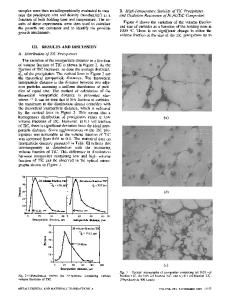Investigation of Ni 3 Al-matrix composites strengthened by TiC
- PDF / 816,066 Bytes
- 5 Pages / 576 x 792 pts Page_size
- 52 Downloads / 448 Views
In this paper, the possibilities of preparing TiC-reinforced Ni3Al-matrix composites by SM (self-propagating high temperature synthesis and melting process) were examined. Two kinds of composites, namely, commercial TiC-reinforcement and synthesized TiC-reinforcement Ni3Al-matrix composites, were fabricated. The effects of particle size of the commercial TiC on the mechanical properties of the Ni3Al-matrix composites were studied. The results show that the mechanical properties of the composites decrease with increasing particle size of the commercial TiC. The microstructures of 35 wt. % TiC + 65 wt. % Ni3Al composites produced by SM technology from the four elements Ti, C, Ni, and Al were examined. The results show that in these composites, the particle size of TiC synthesized in situ is fine and that the materials have considerable high-temperature bending strength and fracture toughness.
I. INTRODUCTION Metal-matrix composites strengthened by ceramics have become appealing as a new kind of engineering material. One hopes that the materials possess the high temperature properties of ceramics, and the fracture toughness and workability of metals. As is well known, the intermetallic compound, Ni 3 Al, existing in an ordered structure, has some novel characteristics. For example, its yield stress increases with increasing temperature, rather than decreases as is common in disordered alloys.1 Although single crystals of nickel aluminide are ductile, polycrystalline Ni3Al is extremely brittle. On the basis of former work, its brittleness can be alleviated by adding small quantities1'2 of boron, zirconium, cadmium, manganese, and titanium so that the improved Ni3Al can be used as a component of composites. If titanium carbide (TiC) particles are uniformly dispersed in the Ni3Al matrix by a particular process, a considerable increase in the high temperature strength of Ni3Al may be reached while the original metal properties are maintained. The high temperature strength of the Ni3Al-matrix composites is also strongly affected by the particle size of the reinforcement phase (TiC).3'4 Although the commercial TiC particles may be fine, their surface may become contaminated and oxidized due to exposure of the unblended reinforcements to the processing environment. This can lead to the development of an oxide surface layer that can affect the adherence of the reinforcement to the parent matrix, and, thus, contribute to failure at the interface. Therefore, it is difficult to prepare the composite material with novel properties from elemental powders via the conventional powder metallurgy (HP, HIP, and so on). 2830 http://journals.cambridge.org
J. Mater. Res., Vol. 8, No. 11, Nov 1993 Downloaded: 15 Mar 2015
An advanced process developed at our laboratory enables the intermetallic alloy-matrix composites to be produced successfully and to have good properties. This technology that includes self-propagating high-temperature synthesis and melting (called SM technology) produces ceramic reinforcements in situ during the meltin
Data Loading...











